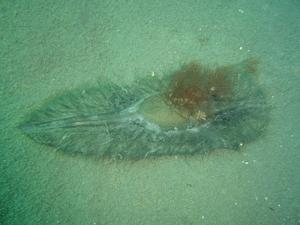Edgardo Ernesto Di Giacomo
The aim of this project is to locate the egg-laying areas for several species of skates and one holocephalan, and quantify the amount of egg cases laid per reproductive season for identify sensitive areas for their protection and estimate fundamental life history parameters needed for the design of conservation and fishery management measure.

Egg case with embryos of Callorhinchus callorhynchus on sea bed in egg laying zone. Sand bottom.
The San Matías Gulf (41°– 42° S; 64°– 65° W) is one of the most conspicuous marine environments of Patagonia. This gulf is a relatively isolated ecosystem. In its waters, a small-scale trawl fishery has been developing since 1971. The target species is the hake, Merluccius hubbsi; nevertheless, 18 skates, 11 sharks and 1 holocephali species are captured as bycatch. These species are key components of their marine ecosystem and are also particularly vulnerable to fishing pressure. In recent years, 33% of these species were included in the IUCN Red List. Besides the risk of extinction of some species, a further concern is the ecosystem impacts that may result from the strong depletion of their populations.

One-year old Callorhinchus callorhynchus predated by a Sparidae, a common specie in the coast zone (from surface to 80m deep).
However, a successful conservation plan seems to be possible. The northern region of San Matías Gulf appears to be a sensitive area for the conservation of these species. The highest concentrations of the holocephalan, Callorhinchus callorhynchus, occur there and egg cases from several chondrichthyans are also found. The localization of a possible spawning area and the quantification of biological parameters will contribute to the development of conservation plans and fishery management policies for these highly vulnerable species.
The growing concern about the fishing exploitation level of chondrichthyan species expressed by international organisms like FAO and IUCN is directly related to their vulnerability as fishing resources. In the last years, many cases of overexploitation and even local extinctions of some of these species have been detected. Being able to identify and to delimit the egg-laying areas for the cockfish and skates, as well as to register the presence of individuals recently hatched, will be essential to develop specific management plans. These could include the closure of areas during the reproductive season in order to protect the growth of embryos within egg cases and the newborns from human activities. The estimation of biological parameters such as fecundity and predation mortality will help to design management plans for the local fishery that ensure the conservation of the resource. Beyond the local impact, the information obtained will be incorporated into national and international data bases to make it available to the scientific community and to fisheries administrations. Information will also be published in local magazines and journals in order to raise community awareness of the research activities and the need for care of natural resources.